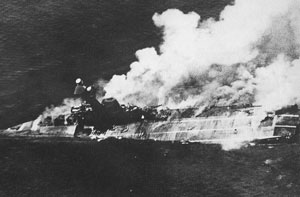75th Independence
Sporadic bombs that fell here and there
View(s):- Extracts from ‘O.E.G – A biography of Sir Oliver Goonetilleke’ by Sir Charles Jeffries
It was still in the early hours of the morning when I received a call from Governor Caldecott. He had spent the night in a specially constructed slit-trench shelter as Queen’s House, being a well-known landmark, was considered unsafe.
He, too, asked whether people were to be allowed to go to church. I advised him to go to church himself. I said I expected the air-raid about the time people would be in church. And I added that I expected services to go on.

The sinking of the Hermes aircraft carrier
There was a lot of activity in the air, according to radar information, but there was still no precise indication of the timing of the attack. It came suddenly. At 7.50 a.m, I was in the operations room opposite my own control room when we noticed the enemy planes flying in. I gave the order for the air raid sirens to shrill their warning without any further signals or signs. I saw the planes going over us in the direction of Ratmalana, which is just outside the southern borders of Colombo. Apart from the airport, Ratmalana also includes a number of important government workshops. The enemy planes were flying in groups of five, with a battle leader for each group. One of them was flying so low that he was shot down and became the first enemy casualty. We recovered his body the next day. He had expected his fate. He was in full dress uniform and had pinned his row of medals over his now silent heart. We gave him a full military funeral later.
The total casualties of the raid were about eighty-five civilians killed and seventy-seven injured. Sporadic bombs that fell here and there in a raid of this type did not, fortunately, cause the fire damage that could have occurred.
The enemy force received a much stiffer reception than it had expected. As the aircraft flew away from Ceylon, ARP observers stationed at the southernmost town in the island noted that, of the eighty-five planes that flew into attack, only fifty-four were returning. Our losses were nineteen fighters and six Swordfish.
There was only one minister who did not join the congratulations on Ceylon’s showing, which was the first significant setback to the enemy’s hitherto all-conquering progress. This was the Minister of Health, the late Mr George de Silva. He was most bitter about my failure to have the roofs of the mental hospital at Angoda, outside Colombo, painted with Red Cross symbols. My attempts to quieten him, saying that it was in the larger interests of Ceylon, that the enemy had mistaken the mental hospital for the power station, only increased his fury.
After the planes had flown away, Colombo had its biggest exodus ever, and the absence of labour was felt most in the port of Colombo.
The war was now very much in our court and the Japanese were inflicting heavy damage on the British fleet. Four days after the raid in Colombo, they struck at Trincomalee, driving terror into the heart of citizens in this strategic base. The enemy’s onslaught on Trincomalee was more successful than the attack on Colombo, and the damage to British shipping was greater. The Japanese on their part, lost fourteen of the fifty four planes that flew into the attack.
When flying back after the attack, they spotted the aircraft carrier Hermes off Kalkudah, a small fishing village off the eastern coast. They dropped bombs around the ship as a warning to the crew and to make sure it was not carrying fighter planes. They returned an hour later and destroyed the Hermes.
So ended Ceylon’s active war; sharp while it lasted, but mercifully short. But Ceylon was by no means out of the war. It was an essential operations base for South-east Asia, and an essential source of much needed raw materials.

